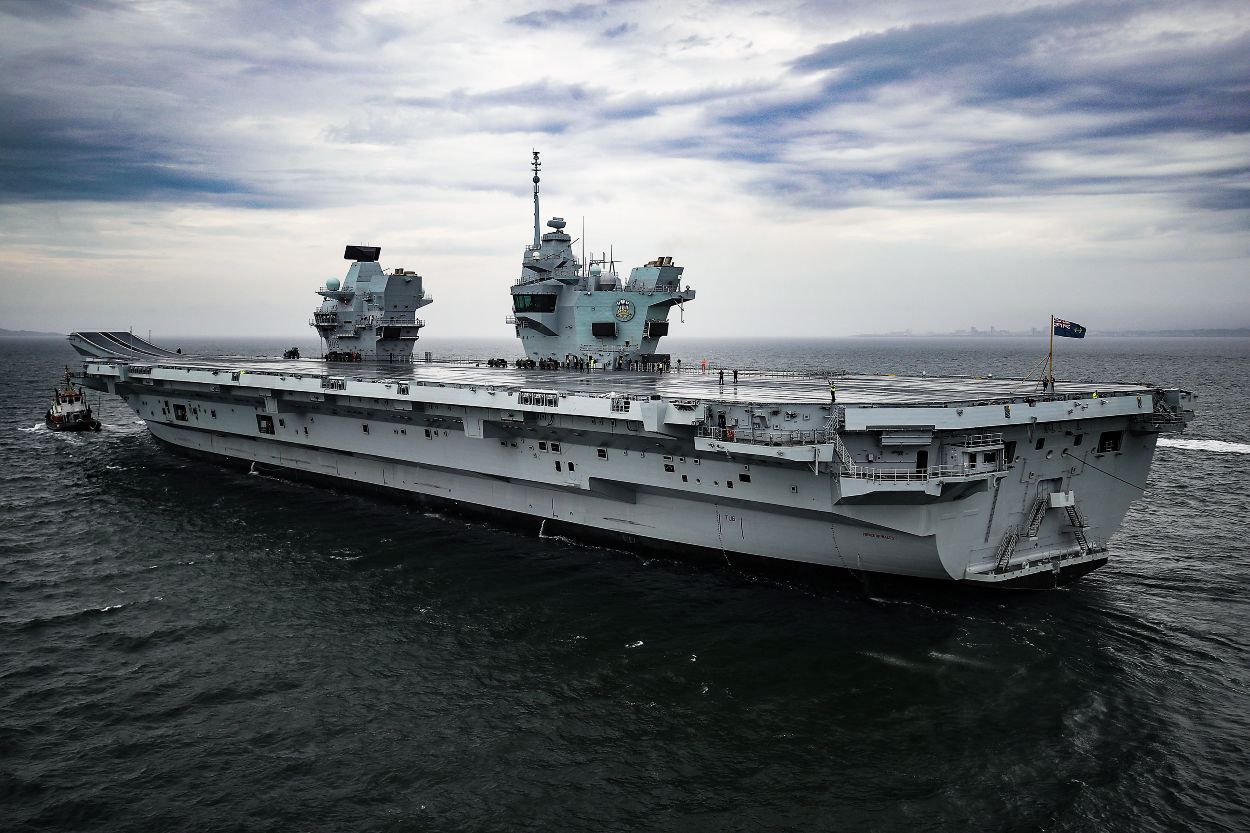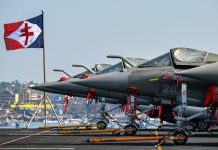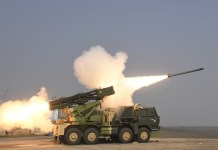Two centuries ago, the Sun would never set on the British Empire, which was built on the strength of its Navy. However, a 17-year pause in shipbuilding has proved detrimental to the Royal Navy’s capability.
Its aging and overstretched naval platforms mean that in 2025, the Royal Navy’s aircraft carrier, HMS Prince of Wales, will need protection from the Norwegian Navy during its deployment to the Pacific region.
The Norwegian government announced on August 6 that Norway will join the UK’s Carrier Strike Group deployment to Japan and the Indo-Pacific region in 2025. Norway’s navy will be providing two warships, including a frigate. Most probably, it will be one of Norway’s four Nansen-class frigates.
The Carrier Strike Group, led by HMS Prince of Wales, is one of Britain’s two aircraft carriers. It will be accompanied by her escorts and F-35B Lightning jets and will work alongside the Japanese Self Defence Forces with a mission to defend peace and stability in the Indo-Pacific. The 2025 Carrier Strike Group deployment will last around seven months.
The UK government categorized the Norwegian participation in the deployment as a demonstration that “the security of the Euro-Atlantic region and Indo-Pacific is indivisible.” However, all the euphemisms cannot hide the fact that the Royal Navy is grappling with dwindling platforms.
During the Falkland Wars, the Royal Navy had four aircraft carriers, but this number has been reduced to two. The number of destroyers has also come down from 13 to six. From a whopping 51 frigates in 1982, the Navy now has only six frigates. The number of submarines has also decreased from 37 to 10.
The remaining warships are old, overworked, and fast approaching retirement. In the coming years, its aircraft carrier will need escorts from its friendly navies.
The lack of capacity means the Royal Navy will not be able to assign any frigate to escort its aircraft carrier as they also handle another critical mission of towing the Sonar to detect Russian submarines slipping from their anchorages into the wider Atlantic Ocean. The nine frigates were also required for urgent tasks like shadowing Russian or Chinese warships transiting through British waters.
The Royal Navy’s strength is woefully short to deal with the emerging threats, especially in the Indo-Pacific. With the Chinese Navy’s sojourn increasing close to home, the Royal Navy needs an aggressive plan to get new naval platforms. Over the past month, a Royal Navy frigate monitored a Chinese naval task force twice as it passed through the English Channel and back again.
The HMS Richmond monitored the PLA Navy destroyer Jiaozuo and the fleet auxiliary Honghu as they transited to and from Russia’s Navy Day parade in St. Petersburg.
The two warships used the right of innocent passage to transit UK waters of the North Sea and the Channel. The last time the Royal Navy monitored PLA Navy vessels on their way to St. Petersburg’s parade was in 2019 when the destroyer Xian transited the same event.
The UK’s Ministry of Defense is working to usher in a “new golden age” of shipbuilding. The Royal Navy has 28 warships and submarines in the pipeline, backed by defense spending rising to 2.5% of GDP. The warships planned include eight Type 26 and five Type 31 frigates. Both these types are running behind schedule, while decades-old Type 23 are aging. When Yarrow Shipbuilders and Swan Hunter built the Type 23s between the late 1980s and early 2000s to keep the costs down. That meant keeping their hulls thin.
Thereafter, the Royal Navy did not cut steel for any warship for 17 years. As the Type 23 rusted away, the Royal Navy had to take the hard decision of decommissioning its fourth Type 23 frigate much before its planned date. This left the Navy with only nine frigates in 2024.
The numbers of the frigates are expected to dip further before the Royal Navy fleet does not start growing, but not before 2027. It could be 2031 before the fleet has 13 frigates again.

The Royal Navy’s Quest To Rise Again
In a report published in December 2021, the Defence Committee worried that the Royal Navy’s fleet is “too small and too specialized.” The Committee also expressed concern about the current availability of ships, with aging vessels retained in service before being replaced with new ships.
In recent years, the debate about the procurement of naval surface ships has focused on where the ships are built. The UK government has been focused on supporting the UK’s shipbuilding industry and retaining while keeping the budget down. There are also concerns about timescales and delays to programs and the effect this may have on the Royal Navy’s ability to fulfill the demands placed on it.
Considering this, in 2024, the Royal Navy placed an order for six new state-of-the-art multi-role support ships (MRSS) for the Royal Marines Commandos. The amphibious warships would bring the commandos ashore wherever they are needed.
The new Multi-Role Support Ships (MRSS) will replace HMS Albion and HMS Bulwark, the Royal Navy’s current amphibious flagships, which will remain in service until 2033/2034. The MRSS will also replace the three Bay-class amphibious support vessels, RFAs Lyme Bay, Mounts Bay, and Cardigan Bay, and support ship RFA Argus.
The versatile warships will be able to perform a variety of operations and are designed to carry vehicles, aircraft, insertion craft, and a broad range of uncrewed systems for complicated missions.
China launching ships like ‘dumping dumplings into broth’
In comparison, China’s People’s Liberation Army – Navy (PLA-N), the world’s largest, has been growing feverishly, leaving even the US Navy far behind in terms of ship construction capability.
The pace with which the PLA-N inducts warships has often been likened to “dumping dumplings into soup broth.” A leaked US Navy Intelligence presentation slide estimates the Chinese shipyard’s construction capacity is 232 times more than the US shipbuilding prowess.
Sometime between 2015 and 2020, China overtook the US in the number of warships in its fleet, and the gap between the two navies has been fast growing. The Pentagon’s annual report to the US Congress on Chinese military and security developments estimates that the Chinese Navy had 350 warships compared to 293 warships in the US Navy battle force.
The yawning gap of 60 hulls between the two navies is expected to grow every five years until 2035, when China will have an estimated 475 naval ships compared to 305-317 US warships.
Between 2017 and 2019, China reportedly built more vessels than India, Japan, Australia, France, and the United Kingdom combined. Germany’s Vice Admiral Kay-Achim Schonbachsaid noted in 2021 that China’s navy is expanding by roughly the equivalent of the entire French navy every four years.
- Ritu Sharma has been a journalist for over a decade, writing on defense, foreign affairs, and nuclear technology.
- The author can be reached at ritu.sharma (at) mail.com
- Follow EurAsian Times on Google News




